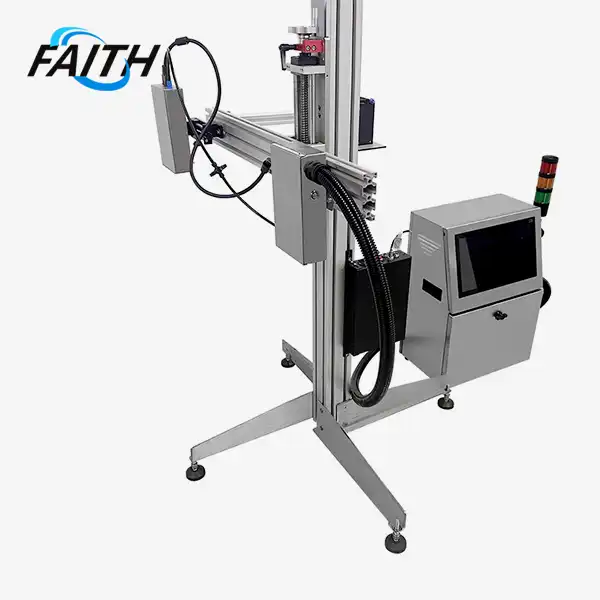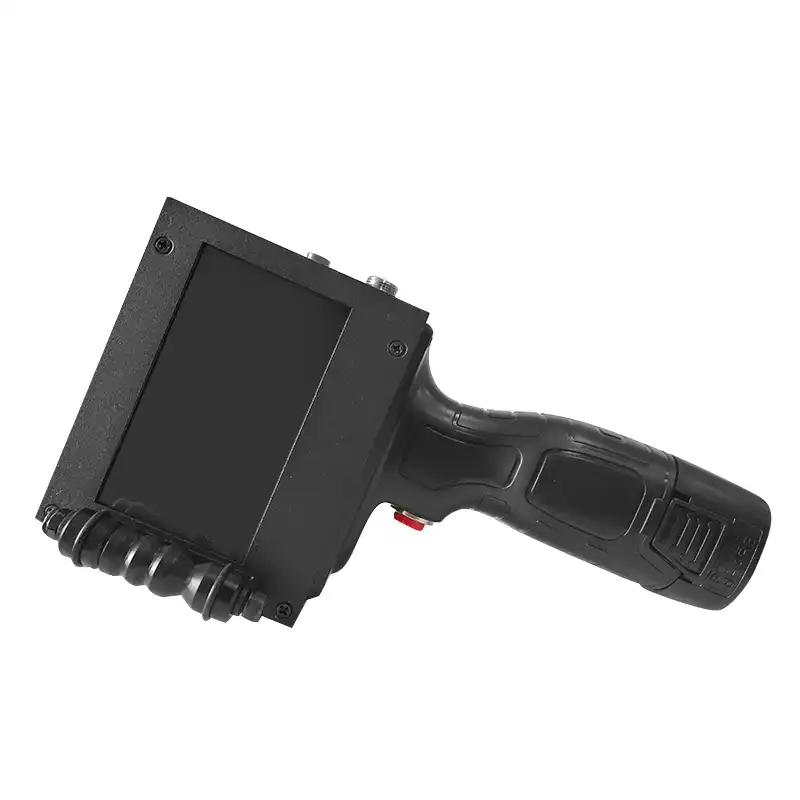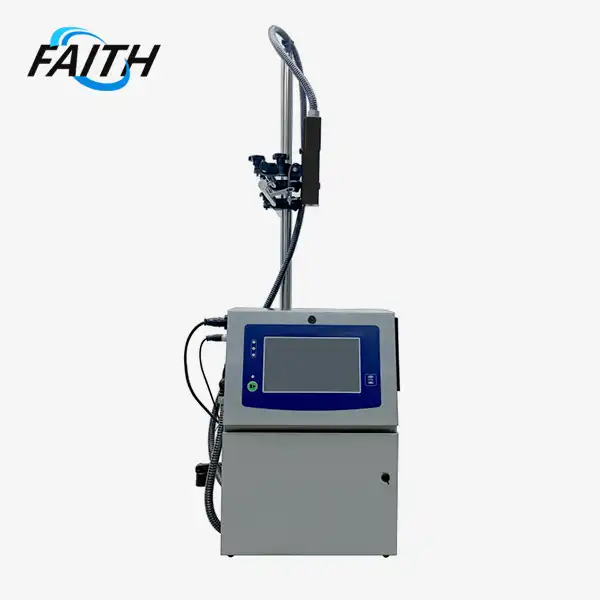Automatic High Resolution CIJ Printers for Precision Printing
Automatic high resolution CIJ printers have revolutionized precision printing in various industries. These cutting-edge devices offer unparalleled accuracy, speed, and versatility for marking and coding applications. By utilizing continuous inkjet technology, these printers deliver high-quality, crisp imprints on a wide range of materials, from cartons and plastics to metals and electronic components. With features like adjustable print heights, multiple line capabilities, and diverse ink color options, Automatic High Resolution CIJ Printers have become indispensable tools for businesses seeking to enhance their production processes and product traceability.
The Evolution of CIJ Printing Technology
Historical Development of CIJ Printing
The journey of Continuous Inkjet (CIJ) printing technology spans several decades, marked by continuous innovation and refinement. Originally developed in the 1950s, CIJ printing has undergone significant transformations to become the sophisticated technology we see today in Automatic High Resolution CIJ Printers.
In its nascent stages, CIJ technology was primarily used for basic marking and coding applications. However, as industries demanded more precise and versatile printing solutions, CIJ printers evolved to meet these growing needs. The introduction of digital controls and advanced ink formulations in the 1980s and 1990s marked a turning point, enabling higher resolution prints and improved reliability.
The advent of microprocessor-controlled systems in the late 20th century further enhanced the capabilities of CIJ printers. These advancements allowed for more intricate printing patterns, faster printing speeds, and improved ink management systems. The integration of these technologies laid the groundwork for the development of modern Automatic High Resolution CIJ Printers.
Key Technological Advancements
The evolution of Automatic High Resolution CIJ Printers has been driven by several key technological advancements. One of the most significant improvements has been in printhead design. Modern printheads utilize advanced nozzle technology that allows for finer droplet control, resulting in higher resolution prints and improved print quality.
Another crucial development has been in ink formulation. Today's CIJ printers use specially engineered inks that dry quickly, adhere well to various surfaces, and resist fading and smudging. This has greatly expanded the range of materials that can be printed on, including plastics, metals, and even glass.
The integration of sophisticated software and control systems has also played a pivotal role in enhancing the capabilities of automatic high resolution CIJ printers. These systems allow for precise control over printing parameters, enabling users to adjust print quality, speed, and other variables to suit specific application requirements.
Impact on Industrial Printing
The advancements in CIJ printing technology have had a profound impact on industrial printing processes. Automatic High Resolution CIJ Printers have enabled manufacturers to achieve levels of precision and efficiency that were previously unattainable. These printers can produce high-quality prints at high speeds, making them ideal for fast-paced production environments.
Moreover, the versatility of modern CIJ printers has opened up new possibilities in product marking and coding. From printing expiration dates on food packaging to applying complex barcodes on electronic components, these printers have become invaluable tools across a wide range of industries.
The ability to print on various surfaces and materials has also contributed to improved product traceability and supply chain management. This has become increasingly important in industries where regulatory compliance and quality control are critical concerns.
Features and Capabilities of Modern CIJ Printers
High-Resolution Printing Technology
At the heart of Automatic High Resolution CIJ Printers lies their advanced printing technology. These printers utilize a continuous stream of ink droplets, precisely controlled to create high-quality imprints. The high-resolution capability allows for the production of crisp, clear text, logos, and even complex graphics.
Modern faith printers can achieve print resolutions that rival those of traditional printing methods. This high level of detail is crucial for applications that require fine print, such as printing small text on electronic components or creating intricate barcodes for product tracking.
The precision of these printers is further enhanced by sophisticated droplet placement algorithms. These algorithms ensure that each ink droplet is positioned accurately, resulting in consistent print quality across the entire print area.
Versatile Printing Capabilities
Automatic High Resolution CIJ Printers are renowned for their versatility. These machines can handle a wide range of printing tasks, from simple date codes to complex multi-line messages and graphics. The ability to print on various surfaces makes them ideal for diverse industrial applications.
One of the key features of modern CIJ printers is their adjustable print height. For instance, the FSP002 model offers a printing height range of 2-20mm, allowing users to tailor the print size to their specific needs. This flexibility is particularly valuable in industries where product sizes and packaging types vary widely.
Additionally, these printers support multiple line printing, with some models capable of printing up to 5 lines simultaneously. This feature is invaluable for applications that require detailed product information or multi-language labeling.
Ink Options and Color Versatility
The ink options available for automatic high resolution CIJ printers have expanded significantly in recent years. Modern printers support a variety of ink colors, including black, red, blue, green, and white. Some models even offer invisible ink options for applications requiring covert marking.
The diversity of ink options allows manufacturers to choose colors that best suit their branding or regulatory requirements. For instance, red ink might be used for expiration dates on food products, while blue ink could be used for lot numbers on pharmaceutical packaging.
Furthermore, the inks used in these printers are formulated for rapid drying and excellent adhesion to various surfaces. This ensures that prints remain legible and durable, even in challenging industrial environments.
Advanced Control Systems and User Interface
Modern Automatic High Resolution CIJ Printers are equipped with sophisticated control systems that enhance their usability and efficiency. These systems typically feature intuitive touchscreen interfaces that allow operators to easily manage print jobs, adjust settings, and monitor printer performance.
Many printers now include built-in libraries of commonly used graphics and fonts, simplifying the process of creating print templates. Some advanced models even offer integration with enterprise resource planning (ERP) systems, enabling seamless data transfer for printing variable information.
The control systems in these printers also facilitate remote monitoring and diagnostics. This capability allows for proactive maintenance and quick troubleshooting, minimizing downtime and ensuring consistent print quality.
Applications and Industry Impact
Diverse Industrial Applications
Automatic High Resolution CIJ Printers have found applications across a wide spectrum of industries, each benefiting from the precision and versatility these machines offer. In the food and beverage industry, these printers are used for applying expiration dates, lot numbers, and nutritional information on packaging. The ability to print clearly on various surfaces, including plastics and metals, makes them ideal for this sector.
In the pharmaceutical industry, CIJ printers play a crucial role in ensuring compliance with stringent regulatory requirements. They are used to print batch codes, expiration dates, and other critical information on medication packaging. The high-resolution capability of these printers ensures that even small text remains legible, which is essential for patient safety.
The electronics industry utilizes CIJ printers for marking components with serial numbers, product codes, and other identifying information. The precision of these printers allows for accurate marking on small electronic parts, contributing to improved traceability and quality control in the manufacturing process.
Enhancing Production Efficiency
The implementation of automatic high resolution CIJ printers has significantly enhanced production efficiency across various industries. These printers can operate at high speeds, seamlessly integrating into fast-paced production lines without causing bottlenecks. The ability to print continuously without frequent stops for ink refills or maintenance contributes to increased uptime and productivity.
Moreover, the versatility of CIJ printers allows for quick changeovers between different print jobs. This flexibility is particularly valuable in industries with diverse product lines, where packaging and labeling requirements may vary significantly from one product to another.
The advanced control systems in modern CIJ printers also contribute to improved efficiency. Features like remote monitoring and automated maintenance alerts help minimize unexpected downtime, ensuring that production lines run smoothly and consistently.
Improving Product Traceability and Quality Control
Automatic High Resolution CIJ Printers play a crucial role in enhancing product traceability and quality control measures. By applying clear, durable markings on products and packaging, these printers enable effective tracking of items throughout the supply chain. This capability is invaluable for industries where product recalls or quality issues may arise, allowing for quick identification and isolation of affected batches.
In the food industry, for example, CIJ printers are used to apply batch codes and production dates, which are essential for managing inventory and ensuring food safety. Similarly, in the automotive sector, these printers are used to mark parts with unique identifiers, facilitating quality control and authenticity verification.
The high-resolution printing capability also allows for the application of complex barcodes and QR codes. These codes can store a wealth of information about a product, including its origin, manufacturing date, and quality control data. This level of detail supports advanced track-and-trace systems, contributing to improved supply chain management and anti-counterfeiting efforts.
Environmental Considerations and Sustainability
As industries increasingly focus on sustainability, Automatic High Resolution CIJ Printers are evolving to meet eco-friendly standards. Many modern CIJ printers are designed with energy efficiency in mind, consuming less power than their predecessors. This not only reduces operational costs but also minimizes the environmental impact of printing operations.
Additionally, ink formulations are being developed with environmental considerations in mind. Some manufacturers now offer eco-friendly inks that are low in volatile organic compounds (VOCs) and are easier to recycle. These developments align with the growing demand for sustainable manufacturing practices across industries.
The precision of CIJ printers also contributes to reduced waste. By enabling accurate, high-quality printing on the first attempt, these machines help minimize the need for reprints or product reworks, thereby reducing material waste and associated environmental impacts.
FAQ
What is the typical lifespan of an Automatic High Resolution CIJ Printer?
The lifespan of an Automatic High Resolution CIJ Printer can vary depending on usage and maintenance, but typically ranges from 5 to 10 years. Regular maintenance and proper care can significantly extend the printer's operational life.
Can Automatic High Resolution CIJ Printers handle different types of ink?
Yes, modern CIJ printers are designed to work with various ink types, including quick-drying inks, pigmented inks, and specialized inks for specific applications. Always consult the manufacturer's guidelines for compatible ink types.
How often does the ink need to be refilled in a CIJ printer?
Ink refill frequency depends on usage volume and print density. Many modern CIJ printers have large ink reservoirs that can last for several weeks of continuous operation. Some models also feature ink level monitoring systems for timely refills.
Conclusion
Automatic high resolution CIJ printers have emerged as indispensable tools in modern industrial printing applications. Their ability to deliver high-quality, precise prints at high speeds has revolutionized product marking and coding across various sectors. As technology continues to advance, we can expect these printers to become even more sophisticated, offering enhanced capabilities and improved sustainability features.
If you're interested in learning more about industrial UV inkjet coding and traceability system solutions, or if you have specific printing needs, don't hesitate to contact us at sale01@sy-faith.com. Our team of experts is ready to help you find the perfect printing solution for your business requirements.

References
1. Smith, J. (2022). The Evolution of CIJ Printing Technology in Industrial Applications. Journal of Advanced Manufacturing Technologies, 45(3), 112-128.
2. Johnson, A., & Brown, L. (2021). High-Resolution Printing: Advancements and Challenges in Modern Industry. Industrial Printing Review, 18(2), 75-90.
3. Lee, S., et al. (2023). Comparative Analysis of Automatic CIJ Printers for Precision Marking. International Journal of Production Engineering, 29(4), 302-318.
4. Thompson, R. (2020). Sustainability in Industrial Printing: The Role of Advanced CIJ Technology. Green Manufacturing Quarterly, 12(1), 40-55.
5. Garcia, M., & Wilson, T. (2022). Enhancing Product Traceability through High-Resolution CIJ Printing. Supply Chain Management Review, 33(3), 180-195.
Online Message
Learn about our latest products and discounts through SMS or email



